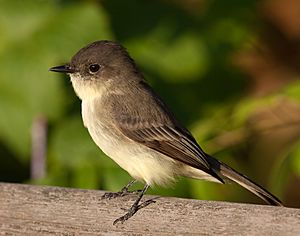Eastern phoebe facts for kids
Quick facts for kids Eastern phoebe |
|
|---|---|
 |
|
| At Madison, Wisconsin | |
| Conservation status | |
| Scientific classification | |
| Genus: |
Sayornis
|
| Species: |
phoebe
|
 |
|
The eastern phoebe (Sayornis phoebe) is a small songbird. It belongs to a group of birds called passerines. The name Sayornis comes from an older name for a similar bird, Muscicapa saya, and the Ancient Greek word ornis, meaning "bird". The name "Phoebe" might be from the Roman moon-goddess Diana. But it probably comes from the bird's own song, which sounds like "fee-bee"!
Contents
What the Eastern Phoebe Looks Like
This bird is about 14 to 17 centimeters (5.5 to 6.7 inches) long. It weighs around 16 to 21 grams (0.6 to 0.7 ounces). Its wings can spread out about 26 to 28 centimeters (10.2 to 11.0 inches).
The eastern phoebe looks like it has a big head. Its feathers are gray-brown on top. It has a white throat and a gray chest. Its belly is a light yellowish-brown, which turns whiter during the breeding season. You might see two faint, light-colored bars on each wing.
You can tell it apart from other birds because it doesn't have a ring around its eye. It also has an all-dark beak. When it sits on a branch, it often bobs its tail up and down. This is a special habit of phoebes. Its call is a sharp chip. Its song, which gives it its name, sounds like fee-bee.
The eastern wood pewee (Contopus virens) looks very similar. However, the eastern wood pewee usually has clearer, brighter wing-bars. It also does not bob its tail as much as the phoebe.
Where They Build Nests
Eastern phoebes often build their nests on human-made structures. These can include bridges or buildings. They might start building nests as early as April. The nest is shaped like an open cup. It has a base made of mud and is lined with moss and grass. They build it in cracks in rocks or on human-made spots.
A female phoebe usually lays two to six eggs. Both parent birds help feed the young. They often raise two groups of babies each year. Sometimes, another bird called the brown-headed cowbird (Molothrus ater) lays its eggs in a phoebe's nest. The phoebe then raises the cowbird's chick as its own.
Where They Live and Eat
This type of tyrant flycatcher lives in eastern North America. However, it does not usually live along the southeastern coast of the United States.
Eastern phoebes like open woodlands, farms, and suburbs. They often live near water. These birds mostly eat insects. They often sit in a clear spot while looking for food. When the weather gets cooler, they also eat fruits and berries.
Their Amazing Journeys
Eastern phoebes are migratory birds. This means they travel to warmer places for winter. They spend winter in the southernmost United States and Central America. It is very rare to see one in western Europe.
These birds are among the first to return to their breeding areas in spring. They are also among the last to leave in the fall. They usually arrive for breeding in mid to late March. They return to their winter homes around September and early October. Their migration times have stayed the same for the last 100 years. More trees have grown in the Great Plains over the last century. This has helped the eastern phoebe, and many other birds, spread their living areas further west.
Photo gallery
-
Taken at Cap Tourmente National Wildlife Area, Quebec
-
Nest with one brown-headed cowbird egg
Images for kids
See also
 In Spanish: Mosquero fibí para niños
In Spanish: Mosquero fibí para niños










